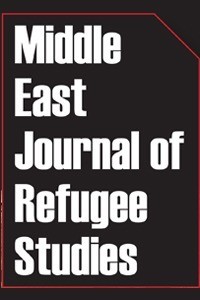Ayrımcılık ve Sömürü: Kumkapı’daki Afrikalı Sığınmacıların Çalışma Koşulları ve Sığınmacılara Yönelik Tutumlar
Türkiye, coğrafi konumundan dolayı göçmenler için hem bir geçiş hem de hedef ülke olarak algılanmaktadır. Bu göçmenler arasında en belirginleri deri renklerinden ötürü Afrikalı sığınmacılardır. Avrupa’yı ya da gelişmiş dünya ülkelerini nihai hedef olarak tayin etseler de Afrikalı sığınmacılar Türkiye’de bulundukları süre zarfında geçimlerini sağlamak durumundadırlar. Kayıt dışı ekonominin çeşitli sektörlerinde ve çalışma şartlarının iyi olmadığı işlerde istihdam edilen Afrikalılar, çoğu zaman tacize ve dolandırıcılığa maruz kalmaktadırlar. Bu makale, Afrikalıların iş yerinde karşılaştıkları ayrımcılığı ve sömürüyü ele almakta; ırkçı tutumların, fiziksel ve cinsel tacizlerin yanı sıra grubun çaresizliğinin ve savunmasızlığının altını çizmektedir. Makalede, öncelikle sığınmacılara odaklanılarak düzensiz ve geçiş göçü incelenmektedir. İkinci olarak, Afrikalı sığınmacıların Türkiye algılarını ortaya koymak ve Türkiye’ye göç nedenlerini incelemek maksadıyla, Türkiye ve Afrika arasındaki politik ve ekonomik ilişkiler ele alınmaktadır. Ardından araştırmanın bulguları sunulmakta ve tartışılmaktadır. Son olarak, Afrikalı sığınmacıların karşılaştıkları problemlere yönelik birtakım çözüm önerileri ve mevcut durumlarını iyileştirmek için politika tavsiyeleri sunulmaktadır.
Anahtar Kelimeler:
Sığınmacı , Transit göç , Ekonomik sömürü , Ayrımcılık , Afrika , İstanbul
Discrimination and Exploitation: Workplace Conditions and Treatment of African Asylum Seekers Residing in Kumkapı
Due to its geographical position, Turkey has long been regarded by immigrants as a transit and destination country. Among these immigrants, the most noticeable, due to their skin color are the African asylum seekers. Though the majority of African asylum seekers ultimately aim to settle in Europe and other First World countries, they need to earn a living during their stay in Turkey. As this research shows, they are typically employed in various sectors of the informal economy, doing less desirable jobs, and are commonly victims of fraud and abuse. This article addresses the issues of the workplace discrimination and exploitation they face, noting racist attitudes, sexual and physical harassment, and the group’s helplessness and vulnerability. We first examine irregular and transit migration to Turkey, focusing on asylum seekers. Next, to portray Turkey’s image among them and explain their reasons for the migration from Africa to Turkey, we explore political and economic relations between Turkey and African countries. We then present and discuss the findings of the research. Finally, we offer solutions to the problems African asylum seekers face and report suggestions for improving their conditions.
Keywords:
Asylum seekers , Transit migration , Economic exploitation , Discrimination , Africa , Istanbul,
___
- Biehl, K. (2008). Migration ‘securitization’ and its everyday implications: An examination of Turkish asylum policy and practice (2009/1). European University Institute.
- Cole, E., Espin, O. M., & Rothblum, E. D. (1992). Refugee women and their mental health: Shattered societies, shattered lives. New York, NY: Haworth Press.
- Dedeoğlu, S., & Gökmen, C. E. (2011). Göç ve sosyal dışlanma: Türkiye’de yabancı göçmen kadınlar. Ankara, Turkey: Efil.
- Fekete, L. (2001). The emergence of xeno-racism. Race & Class, 43(2), 23–40. doi:10.1177/0306396801432003
- Hsieh, H., & Shannon, S. (2005). Three approaches to qualitative content analysis.
- Qualitative Health Research, 15(9), 1277–1288.
- Icduygu, A. (2006). The labour dimensions of irregular migration (CARIM-RR /05). Florence, Italy: European University Institute. Retrieved from http:// cadmus.eui.eu/handle/1814/6266
- İçduygu, A., & Yükseker, D. (2012). Rethinking transit migration in Turkey: Reality and representation in the creation of a migratory phenomenon. Population, Space and Place, 18(4), 441–456.
- Jastram, K., & Achiron, M. (2001). Refugee protection: A guide to international refugee law. Retrieved from http://www.ipu.org/pdf/publications/refugee_en.pdf
- Krippendorff, K. (2004). Content analysis: An Introduction to its method. London, UK: Sage.
- Lloyd, C. (2003). Anti-racism, racism and asylum-seekers in France. Patterns of Prejudice, 37(3), 323–340. doi:10.1080/00313220307590
- Loescher, G. (1993). Beyond charity: International cooperation and the global refugee crisis. New York, NY: Oxford University Press.
- Martin, S. (1992). Refugee women. London, UK: Zed Books.
- Organisation for Economic Co-operation and Development. (2014). How can migrants’ skills be put to use? Retrieved from http://www.oecd.org/els/mig/migration- policy-debates-3.pdf
- Özkan, M., & Akgün, B. (2010). Turkey’s opening to Africa. Modern African Studies, (4), 525–546.
- Schuster, L. (2004). The exclusion of asylum seekers in Europe. Retrieved from https:// www.compas.ox.ac.uk/fileadmin/files/Publications/working_papers/WP_2004/ WP0401.pdf
- Sığınmacılar ve Göçmenlerle Dayanışma Derneği. (2011). Askıdaki yaşamlar & algıdaki yaşamlar projesi araştırma raporu. Retrieved from http://www.sgdd.org.tr/ en/dosya/Askidaki_Yasamlar_Algidaki_Yasamlar.pdf
- ISSN: 2149-4398
- Yayın Aralığı: Yılda 2 Sayı
- Başlangıç: 2016
- Yayıncı: Uluslararası Mülteci Hakları Derneği
Sayıdaki Diğer Makaleler
İnsanlık Trajedisine Düşülen Notlar: Kentin Yeni Misafirleri
Ayşe Gür GEDEN, Yusuf ADIGÜZEL
Mülteciler ve Mülteci Çocukların Ruhsal Durumu
Halil EKŞİ, Halim GÜNER, Nesrullah OKAN
Göç Araştırmalarına Eleştirel Bakışlar: Dünden Bugüne Göç Araştırmaları
Politik Üyeliğin “Öteki” Yüzü: Mülteciler, Sığınmacılar, Göçmenler ve Yabancılar
